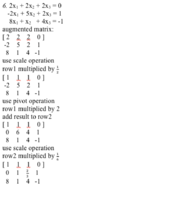You are using an out of date browser. It may not display this or other websites correctly.
You should upgrade or use an alternative browser.
You should upgrade or use an alternative browser.
Solve by Gaussian elimination
- Thread starter frctl
- Start date
- Joined
- Nov 24, 2012
- Messages
- 3,021
Here's how I would work it...begin with the augmented matrix:
[MATH]\left[\begin{array}{ccc|c}2 & 2 & 2 & 0 \\ -2 & 5 & 2 & 1 \\ 8 & 1 & 4 & -1 \end{array}\right][/MATH]
[MATH]\frac{1}{2}R_1[/MATH]
[MATH]\left[\begin{array}{ccc|c}1 & 1 & 1 & 0 \\ -2 & 5 & 2 & 1 \\ 8 & 1 & 4 & -1 \end{array}\right][/MATH]
[MATH]2R_1+R_2[/MATH] and [MATH]-8R_1+R_3[/MATH]
[MATH]\left[\begin{array}{ccc|c}1 & 1 & 1 & 0 \\ 0 & 7 & 4 & 1 \\ 0 & -7 & -4 & -1 \end{array}\right][/MATH]
[MATH]\frac{1}{7}R_2[/MATH]
[MATH]\left[\begin{array}{ccc|c}1 & 1 & 1 & 0 \\ 0 & 1 & \frac{4}{7} & \frac{1}{7} \\ 0 & -7 & -4 & -1 \end{array}\right][/MATH]
[MATH]-R_2+R_1[/MATH] and [MATH]7R_2+R_3[/MATH]
[MATH]\left[\begin{array}{ccc|c}1 & 0 & \frac{3}{7} & -\frac{1}{7} \\ 0 & 1 & \frac{4}{7} & \frac{1}{7} \\ 0 & 0 & -8 & 0 \end{array}\right][/MATH]
[MATH]-8R_3[/MATH]
[MATH]\left[\begin{array}{ccc|c}1 & 0 & \frac{3}{7} & -\frac{1}{7} \\ 0 & 1 & \frac{4}{7} & \frac{1}{7} \\ 0 & 0 & 1 & 0 \end{array}\right][/MATH]
[MATH]-\frac{3}{7}R_3+R_1[/MATH] and [MATH]-\frac{4}{7}R_3+R_2[/MATH]
[MATH]\left[\begin{array}{ccc|c}1 & 0 & 0 & -\frac{1}{7} \\ 0 & 1 & 0 & \frac{1}{7} \\ 0 & 0 & 1 & 0 \end{array}\right][/MATH]
And so we conclude:
[MATH]\left(x_1,x_2,x_3\right)=\left(-\frac{1}{7},\frac{1}{7},0\right)[/MATH]
[MATH]\left[\begin{array}{ccc|c}2 & 2 & 2 & 0 \\ -2 & 5 & 2 & 1 \\ 8 & 1 & 4 & -1 \end{array}\right][/MATH]
[MATH]\frac{1}{2}R_1[/MATH]
[MATH]\left[\begin{array}{ccc|c}1 & 1 & 1 & 0 \\ -2 & 5 & 2 & 1 \\ 8 & 1 & 4 & -1 \end{array}\right][/MATH]
[MATH]2R_1+R_2[/MATH] and [MATH]-8R_1+R_3[/MATH]
[MATH]\left[\begin{array}{ccc|c}1 & 1 & 1 & 0 \\ 0 & 7 & 4 & 1 \\ 0 & -7 & -4 & -1 \end{array}\right][/MATH]
[MATH]\frac{1}{7}R_2[/MATH]
[MATH]\left[\begin{array}{ccc|c}1 & 1 & 1 & 0 \\ 0 & 1 & \frac{4}{7} & \frac{1}{7} \\ 0 & -7 & -4 & -1 \end{array}\right][/MATH]
[MATH]-R_2+R_1[/MATH] and [MATH]7R_2+R_3[/MATH]
[MATH]\left[\begin{array}{ccc|c}1 & 0 & \frac{3}{7} & -\frac{1}{7} \\ 0 & 1 & \frac{4}{7} & \frac{1}{7} \\ 0 & 0 & -8 & 0 \end{array}\right][/MATH]
[MATH]-8R_3[/MATH]
[MATH]\left[\begin{array}{ccc|c}1 & 0 & \frac{3}{7} & -\frac{1}{7} \\ 0 & 1 & \frac{4}{7} & \frac{1}{7} \\ 0 & 0 & 1 & 0 \end{array}\right][/MATH]
[MATH]-\frac{3}{7}R_3+R_1[/MATH] and [MATH]-\frac{4}{7}R_3+R_2[/MATH]
[MATH]\left[\begin{array}{ccc|c}1 & 0 & 0 & -\frac{1}{7} \\ 0 & 1 & 0 & \frac{1}{7} \\ 0 & 0 & 1 & 0 \end{array}\right][/MATH]
And so we conclude:
[MATH]\left(x_1,x_2,x_3\right)=\left(-\frac{1}{7},\frac{1}{7},0\right)[/MATH]
Otis
Elite Member
- Joined
- Apr 22, 2015
- Messages
- 4,592
Hello frctl. Your work shows a mistake in column 2, when you added 2R1 to R2. You've got 2+5=6. Is that a typo?Solve the linear system by Gaussian elimination …
Did you intend to type row3? Your prior work already obtained a pivot (and leading zero) in row2, so move on to row3 (i.e., get two leading zeros in row3 and a pivot in the third column). Note: If you jump forward and backward in the columns, instead of working the columns from left to right, you'll eventually end up turning some of your zeros back into non-zeros.[Next] I could … row1 multiplied by -4 [and] add result to row2
After you get pivots in each column with zeros below them, you'll have row echelon form (REF), so you can then see whether the system is consistent. If it is, then continue to reduced row echelon form (RREF) by getting all zeros above the pivots.
If you're saying that you've forgotten how to do arithmetic with fractions, then you need review before continuing. Well, you will if you're expected to report exact solutions for this type of manual exercise. Is this homework?although I am stuck by obtaining fractions
?

